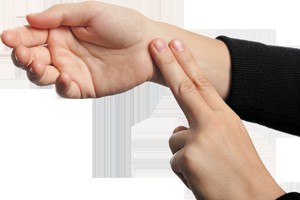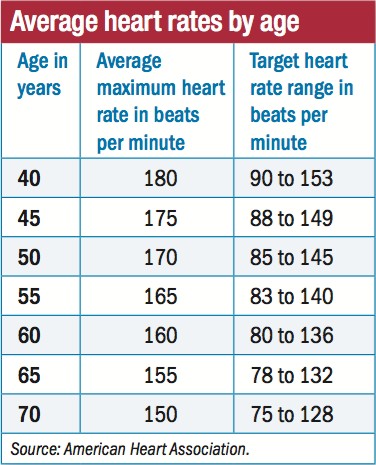The normal pulse rate, also known as heart rate, is an important indicator of cardiovascular health, reflecting how efficiently your heart pumps blood. At WHAT.EDU.VN, we provide clear, accessible information to help you understand your body’s signals, including what constitutes a healthy pulse rate and how factors like age and fitness level influence it, also discover more about resting heart rate and target heart rate. Let’s delve into the essentials of heart rate monitoring and what it means for your well-being, exploring the relationship with blood pressure, heart health, and cardiovascular fitness.
1. What is Considered a Normal Pulse Rate for Adults?
A normal pulse rate for adults typically falls between 60 and 100 beats per minute (BPM) while at rest. However, this range can vary based on individual factors such as age, fitness level, and overall health.
Factors Influencing Normal Pulse Rate
Several factors can influence what is considered a normal pulse rate:
- Age: Pulse rate tends to decrease with age.
- Fitness Level: Athletes often have lower resting pulse rates due to more efficient heart function.
- Medical Conditions: Certain medical conditions can affect pulse rate.
- Medications: Some medications can either increase or decrease pulse rate.
- Emotions: Stress, anxiety, and excitement can temporarily increase pulse rate.
Pulse Rate vs Heart Rate
While the terms are often used interchangeably, pulse rate and heart rate both refer to the number of times your heart beats per minute. Pulse rate is typically measured by feeling the pulsations in an artery, such as in the wrist or neck.
2. How to Measure Your Pulse Rate Accurately
Measuring your pulse rate accurately is simple and can be done at home. Follow these steps for an accurate reading:
- Find a Pulse Point: Common pulse points include the wrist (radial artery) and neck (carotid artery).
- Use Your Fingers: Place your index and middle fingers on the pulse point.
- Count the Beats: Count the number of beats you feel in 15 seconds, then multiply by four to get your pulse rate in beats per minute (BPM).
- Resting State: For an accurate resting pulse rate, measure it when you are relaxed and have been sitting or lying down for at least five minutes.
Tips for Accurate Measurement
- Avoid measuring immediately after exercise or consuming caffeine.
- Ensure you are relaxed and not feeling stressed.
- Use a timer or stopwatch for accurate timing.
- Measure your pulse rate at the same time each day for consistency.
Using Technology to Measure Pulse Rate
Modern technology offers convenient ways to measure your pulse rate, including:
- Smartwatches and Fitness Trackers: These devices continuously monitor your heart rate throughout the day and night.
- Smartphone Apps: Some apps use your phone’s camera and flash to measure your pulse rate through your fingertip.
- Dedicated Heart Rate Monitors: These devices typically use a chest strap to provide accurate heart rate readings during exercise.
3. What is a Resting Heart Rate and Why Does It Matter?
Resting heart rate (RHR) is the number of times your heart beats per minute when you are at complete rest. It’s a key indicator of your cardiovascular health and overall fitness level.
Importance of Resting Heart Rate
- Indicator of Fitness: A lower RHR generally indicates better cardiovascular fitness.
- Early Warning Sign: Changes in RHR can signal underlying health issues.
- Monitoring Tool: Tracking RHR can help monitor the effectiveness of exercise programs.
Factors Affecting Resting Heart Rate
Several factors can influence your resting heart rate:
- Age: RHR tends to increase with age.
- Fitness Level: Athletes typically have lower RHRs.
- Stress: High stress levels can elevate RHR.
- Medications: Certain medications can affect RHR.
- Medical Conditions: Conditions like thyroid disorders can impact RHR.
Ideal Resting Heart Rate Range
For most adults, an ideal resting heart rate falls between 60 and 80 BPM. However, highly trained athletes may have RHRs as low as 40 BPM.
4. Pulse Rate Chart by Age: What’s Normal for Different Age Groups?
Pulse rate varies by age, with different normal ranges for infants, children, and adults. Here’s a general guide:
| Age Group | Normal Resting Heart Rate (BPM) |
|---|---|
| Newborns (0-1 month) | 70-190 |
| Infants (1-12 months) | 80-160 |
| Toddlers (1-2 years) | 80-130 |
| Preschoolers (3-5 years) | 80-120 |
| School-Age Children (6-15 years) | 70-100 |
| Adults (18+ years) | 60-100 |
| Well-Trained Athletes | 40-60 |


Note: These are general guidelines, and individual variations can occur. Consult a healthcare professional for personalized advice.
Pulse Rate in Infants and Children
Infants and children typically have higher pulse rates than adults due to their smaller body size and higher metabolic rate. It’s important to monitor their pulse rate and consult a pediatrician if you have concerns.
Pulse Rate in Older Adults
As people age, their pulse rate may decrease slightly. However, a consistently high or low pulse rate should be evaluated by a healthcare provider.
5. What is Considered a High Pulse Rate (Tachycardia)?
Tachycardia is a condition characterized by a high pulse rate, typically defined as a resting heart rate above 100 BPM.
Causes of Tachycardia
Several factors can cause tachycardia:
- Stress and Anxiety: Emotional stress can temporarily increase heart rate.
- Exercise: Physical activity naturally elevates heart rate.
- Fever: Elevated body temperature can cause tachycardia.
- Medical Conditions: Conditions like anemia, hyperthyroidism, and heart disease can contribute to high pulse rate.
- Medications: Certain medications, such as stimulants and decongestants, can increase heart rate.
Symptoms of Tachycardia
Symptoms of tachycardia may include:
- Rapid Heartbeat: A racing or pounding sensation in the chest.
- Shortness of Breath: Difficulty breathing or feeling winded.
- Dizziness or Lightheadedness: Feeling faint or unsteady.
- Chest Pain: Discomfort or pressure in the chest.
- Palpitations: Awareness of irregular heartbeats.
When to Seek Medical Attention
If you experience symptoms of tachycardia, especially if you have underlying heart conditions, seek medical attention promptly.
6. What is Considered a Low Pulse Rate (Bradycardia)?
Bradycardia is a condition characterized by a low pulse rate, typically defined as a resting heart rate below 60 BPM.
Causes of Bradycardia
Several factors can cause bradycardia:
- High Fitness Level: Athletes often have lower heart rates due to efficient heart function.
- Medications: Beta-blockers and other medications can slow heart rate.
- Medical Conditions: Conditions like hypothyroidism and heart block can contribute to low pulse rate.
- Aging: The natural aging process can sometimes lead to a slower heart rate.
Symptoms of Bradycardia
Symptoms of bradycardia may include:
- Fatigue: Feeling tired or lacking energy.
- Dizziness or Lightheadedness: Feeling faint or unsteady.
- Shortness of Breath: Difficulty breathing or feeling winded.
- Chest Pain: Discomfort or pressure in the chest.
- Fainting (Syncope): Loss of consciousness.
When to Seek Medical Attention
If you experience symptoms of bradycardia, especially if you have underlying heart conditions, seek medical attention promptly.
7. How Does Exercise Affect Your Pulse Rate?
Exercise has a significant impact on your pulse rate. During physical activity, your heart rate increases to meet the body’s increased demand for oxygen and nutrients.
Target Heart Rate Zones
Target heart rate zones are ranges of heart rates that are safe and effective for achieving specific fitness goals during exercise. These zones are typically calculated as a percentage of your maximum heart rate (MHR).
Calculating Maximum Heart Rate
A common formula for estimating maximum heart rate is:
MHR = 220 - AgeFor example, a 30-year-old would have an estimated MHR of 190 BPM.
Target Heart Rate Zones for Different Activities
- Moderate-Intensity Exercise (50-70% of MHR): Suitable for beginners and those looking to improve overall fitness.
- Vigorous-Intensity Exercise (70-85% of MHR): Ideal for improving cardiovascular fitness and burning calories.
- High-Intensity Exercise (85-100% of MHR): Reserved for experienced athletes and short bursts of intense activity.
Benefits of Monitoring Heart Rate During Exercise
- Optimizing Workouts: Ensuring you are exercising at the right intensity for your goals.
- Preventing Overexertion: Avoiding excessive strain on your heart.
- Tracking Progress: Monitoring how your heart rate responds to exercise over time.
8. What Medical Conditions Can Affect Pulse Rate?
Several medical conditions can affect your pulse rate, either increasing it (tachycardia) or decreasing it (bradycardia).
Conditions That Can Cause Tachycardia
- Hyperthyroidism: Overactive thyroid gland.
- Anemia: Low red blood cell count.
- Dehydration: Insufficient fluid in the body.
- Heart Disease: Conditions like atrial fibrillation and supraventricular tachycardia.
- Anxiety Disorders: Panic attacks and generalized anxiety.
Conditions That Can Cause Bradycardia
- Hypothyroidism: Underactive thyroid gland.
- Heart Block: Disruption of electrical signals in the heart.
- Sick Sinus Syndrome: Dysfunction of the heart’s natural pacemaker.
- Sleep Apnea: Interrupted breathing during sleep.
- Electrolyte Imbalances: Abnormal levels of potassium, calcium, or magnesium.
Medications That Can Affect Pulse Rate
Certain medications can also affect your pulse rate:
- Beta-Blockers: Used to treat high blood pressure and heart conditions, can lower heart rate.
- Calcium Channel Blockers: Also used for high blood pressure and heart conditions, can lower heart rate.
- Thyroid Medications: Used to treat thyroid disorders, can increase heart rate.
- Decongestants: Found in cold and allergy medications, can increase heart rate.
- Stimulants: Such as caffeine and ADHD medications, can increase heart rate.
9. How to Improve Your Resting Pulse Rate Through Lifestyle Changes
Improving your resting pulse rate involves making healthy lifestyle changes that promote cardiovascular health.
Regular Exercise
Engaging in regular physical activity is one of the most effective ways to lower your resting pulse rate. Aim for at least 150 minutes of moderate-intensity or 75 minutes of vigorous-intensity aerobic exercise per week.
Healthy Diet
A balanced diet rich in fruits, vegetables, whole grains, and lean proteins supports heart health. Limit your intake of saturated and trans fats, cholesterol, sodium, and added sugars.
Stress Management
Chronic stress can elevate your resting pulse rate. Practice stress-reducing techniques such as:
- Meditation: Focusing on your breath and calming your mind.
- Yoga: Combining physical postures, breathing exercises, and meditation.
- Deep Breathing Exercises: Slow, controlled breathing to activate the relaxation response.
- Spending Time in Nature: Connecting with the outdoors to reduce stress.
Adequate Sleep
Getting enough sleep is crucial for overall health and can help lower your resting pulse rate. Aim for 7-9 hours of quality sleep per night.
Limit Caffeine and Alcohol
Excessive consumption of caffeine and alcohol can increase your heart rate. Limit your intake to moderate levels.
Stay Hydrated
Dehydration can increase your heart rate. Drink plenty of water throughout the day to stay hydrated.
10. Common Myths About Pulse Rate Debunked
There are several misconceptions about pulse rate that need clarification.
Myth 1: A Lower Pulse Rate is Always Better
While a lower resting pulse rate is generally a sign of good cardiovascular fitness, an excessively low heart rate (bradycardia) can be problematic and may require medical attention.
Myth 2: Exercise Should Always Be at Maximum Heart Rate
Exercising at your maximum heart rate for extended periods is not sustainable or safe for most people. Target heart rate zones provide a more balanced approach to exercise.
Myth 3: Pulse Rate is the Same for Everyone
Normal pulse rate varies based on age, fitness level, and overall health. There is no one-size-fits-all number.
Myth 4: Irregular Pulse is Always a Sign of Heart Problems
While an irregular pulse can indicate heart issues, it can also be caused by factors like stress, caffeine, or certain medications. Not all irregular pulses are cause for concern, but they should be evaluated by a healthcare professional.
Myth 5: Monitoring Pulse Rate is Only for Athletes
Monitoring pulse rate can benefit anyone, regardless of their fitness level. It provides valuable insights into your cardiovascular health and can help you make informed lifestyle choices.
Understanding your pulse rate is essential for maintaining good health. By monitoring your heart rate, making healthy lifestyle choices, and consulting with healthcare professionals, you can optimize your cardiovascular well-being. Remember, if you have questions or concerns about your pulse rate, WHAT.EDU.VN is here to provide clear, accessible information.
Do you have more questions about normal pulse rates or other health topics? Visit what.edu.vn to ask your questions and receive free answers from our community of experts. We’re here to help you understand your health better. Contact us at 888 Question City Plaza, Seattle, WA 98101, United States, or WhatsApp us at +1 (206) 555-7890.
